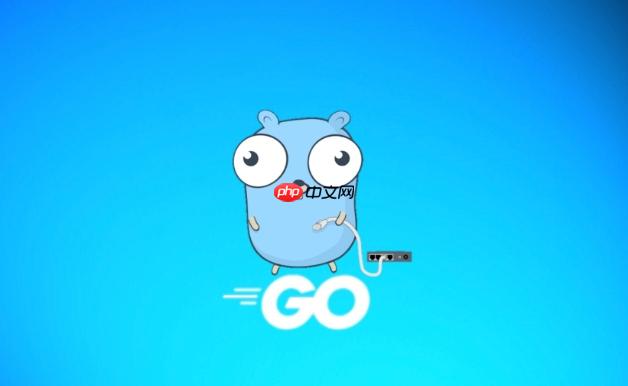golang实现并发任务结果聚合的核心在于fan-in和fan-out模式的正确使用。1. fan-out负责将任务分发给多个worker goroutine并行处理,提升处理速度;2. fan-in则将各worker的结果汇聚到一个channel,便于统一处理。避免goroutine泄露需做到:1. 使用defer关闭channel;2. 使用select语句处理超时;3. 利用context包传递取消信号;4. 确保所有channel都被消费。fan-in/fan-out模式优点包括提高并发性、资源利用率及简化代码逻辑,缺点则为增加复杂性、可能引发资源竞争及需精细管理goroutine生命周期。选择合适的worker数量应根据任务类型调整:1. cpu密集型任务设为cpu核心数;2. io密集型任务可设为大于核心数;3. 通过测试和基准测试确定最优值,并可结合runtime.numcpu()获取系统信息辅助决策。

Golang实现并发任务结果聚合,核心在于利用channel的特性和goroutine的并发能力,通过Fan-in和Fan-out模式高效处理。简单来说,Fan-out负责将任务分发给多个worker goroutine并行执行,Fan-in则负责将这些worker的结果汇聚到一个channel中,供后续处理。

Golang实现并发任务结果聚合的关键在于理解和运用Fan-in和Fan-out模式。

Fan-out: 将单个输入channel的数据分发到多个worker goroutine中并行处理。这可以显著提高处理速度,尤其是在处理计算密集型任务时。
立即学习“go语言免费学习笔记(深入)”;
Fan-in: 将多个channel的数据汇聚到一个channel中。这允许你从多个worker goroutine收集结果,并以统一的方式处理它们。

下面是一个简单的示例,演示了如何使用Fan-in和Fan-out模式来并发计算一组数字的平方,并将结果聚合到一个channel中:
package main
import (
"fmt"
"sync"
)
// worker 函数,计算数字的平方并将结果发送到输出 channel
func worker(id int, jobs <-chan int, results chan<- int) {
for j := range jobs {
fmt.Printf("worker %d processing job %d\n", id, j)
results <- j * j
}
}
// fanIn 函数,将多个输入 channel 的数据合并到一个输出 channel
func fanIn(inputChannels ...<-chan int) <-chan int {
var wg sync.WaitGroup
outputChannel := make(chan int)
// 为每个输入 channel 启动一个 goroutine,将其数据复制到输出 channel
for _, inputChannel := range inputChannels {
wg.Add(1)
go func(inputChannel <-chan int) {
defer wg.Done()
for n := range inputChannel {
outputChannel <- n
}
}(inputChannel)
}
// 启动一个 goroutine,在所有输入 channel 都关闭后关闭输出 channel
go func() {
wg.Wait()
close(outputChannel)
}()
return outputChannel
}
func main() {
// 定义要处理的数字列表
numbers := []int{1, 2, 3, 4, 5, 6, 7, 8, 9, 10}
// 创建一个 jobs channel,用于发送要处理的数字
jobs := make(chan int, len(numbers))
// 创建一个 results channel,用于接收计算结果
results := make(chan int, len(numbers))
// 启动多个 worker goroutine (Fan-out)
numWorkers := 3
for w := 1; w <= numWorkers; w++ {
go worker(w, jobs, results)
}
// 将数字发送到 jobs channel
for _, number := range numbers {
jobs <- number
}
close(jobs)
// 从 results channel 收集结果 (Fan-in)
// 这里先收集results channel到多个中间channel,然后再FanIn
intermediateChannels := make([]<-chan int, numWorkers)
for i := 0; i < numWorkers; i++ {
intermediateChannels[i] = make(chan int, len(numbers)/numWorkers) // 假设每个worker大致处理均等数量的任务
go func(i int, results <-chan int, out chan<- int) {
defer close(out)
count := 0
for r := range results {
if count%numWorkers == i { // 简单的轮询分配
out <- r
}
count++
}
}(i, results, intermediateChannels[i].(chan int)) // 类型断言,因为intermediateChannels是interface切片
}
// 调用 fanIn 函数将多个中间 channel 的数据合并到一个 channel
mergedResults := fanIn(intermediateChannels...)
// 打印计算结果
for result := range mergedResults {
fmt.Println(result)
}
}这个例子中,worker函数负责计算单个数字的平方,并将结果发送到results channel。fanIn函数负责将多个channel的数据合并到一个channel中。main函数创建了jobs和results channel,启动了多个worker goroutine,并将数字发送到jobs channel。最后,它从results channel收集结果并打印出来。
Goroutine泄露是并发编程中常见的问题。避免goroutine泄露的关键在于确保每个goroutine最终都会退出。在Golang中,通常通过以下几种方式来避免goroutine泄露:
defer关闭channel: 确保在不再需要发送数据时关闭channel。这会通知接收者不再有更多数据,接收者可以退出循环。select语句处理超时: 在从channel接收数据时,使用select语句可以设置超时时间。如果超过了超时时间,goroutine可以退出。context包: context包提供了一种传递取消信号的方式。当父goroutine取消时,所有子goroutine都会收到取消信号,并可以退出。优点:
缺点:
选择合适的worker数量是一个需要在实践中进行调整的问题。过多的worker可能会导致过多的上下文切换,反而降低性能。过少的worker则无法充分利用CPU资源。
一些通用的原则:
此外,还可以考虑使用Golang的runtime.NumCPU()函数来获取CPU核心数,并根据实际情况调整worker数量。
以上就是Golang如何实现并发任务的结果聚合 演示Fan-in与Fan-out模式的详细内容,更多请关注php中文网其它相关文章!

每个人都需要一台速度更快、更稳定的 PC。随着时间的推移,垃圾文件、旧注册表数据和不必要的后台进程会占用资源并降低性能。幸运的是,许多工具可以让 Windows 保持平稳运行。

Copyright 2014-2025 https://www.php.cn/ All Rights Reserved | php.cn | 湘ICP备2023035733号